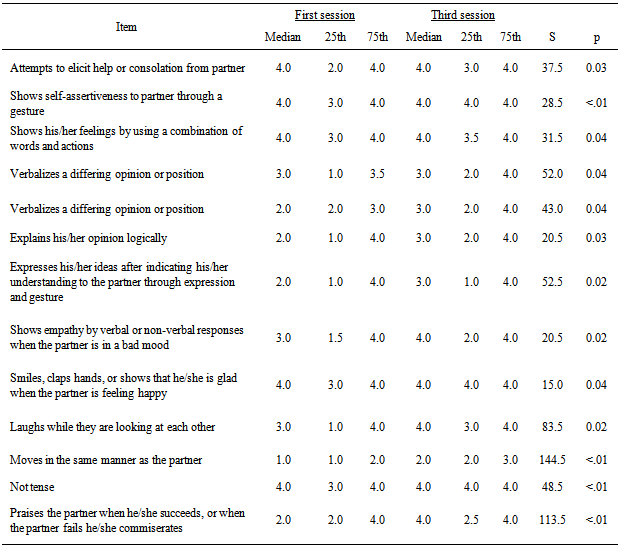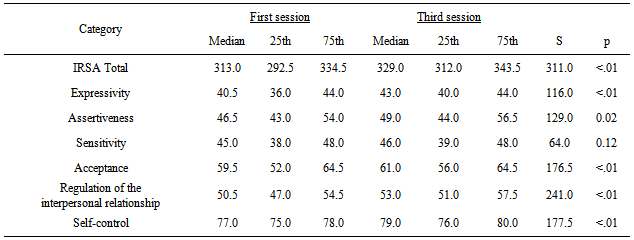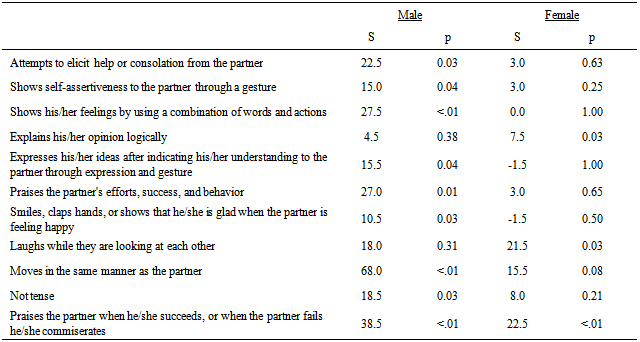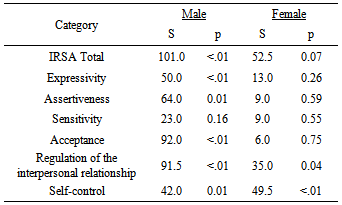-
Paper Information
- Paper Submission
-
Journal Information
- About This Journal
- Editorial Board
- Current Issue
- Archive
- Author Guidelines
- Contact Us
International Journal of Applied Psychology
p-ISSN: 2168-5010 e-ISSN: 2168-5029
2014; 4(2): 50-56
doi:10.5923/j.ijap.20140402.02
Assessing Gender Differences in Sociability towards Strangers over Time Using the Interaction Rating Scale Advanced (IRSA)
Tokie Anme1, Emiko Tanaka1, 2, Kentaro Tokutake1, Taeko Watanabe3, Etsuko Tomisaki1, Yukiko Mochizuki1, Bailiang Wu1, Ryoji Shinohara4, Yuka Sugisawa5, Shuntaro Okazaki6, Norihiro Sadato6
1Faculty of Medicine, University of Tsukuba, Ibaraki, Japan
2Japanese Society for the Promotion of Science, Tokyo, Japan
3Faculty of Nursing, Ashikaga University, Tochigi, Japan
4Faculty of Medicine, University of Yamanashi, Yamanashi, Japan
5Ushiku Health Centre, Ibaraki, Japan
6National Institute for Physiological Sciences, Aichi, Japan
Correspondence to: Tokie Anme, Faculty of Medicine, University of Tsukuba, Ibaraki, Japan.
| Email: |  |
Copyright © 2014 Scientific & Academic Publishing. All Rights Reserved.
The purpose of this study was to identify gender differences in sociability towards a stranger over time using the Interaction Rating Scale Advanced (IRSA) as a context-based practical index of social relationships. Participants were 44 adults who completed three 5-minute interaction sessions, during which they were observed and assessed using the IRSA. Results indicated that all IRSA scores had increased by the third session compared to the first, but that different patterns emerged between genders with respect to changing their behavior towards a stranger over time. Males changed their sociability-related behavior more than did females after they became familiar with the partner. Our results indicate that the IRSA sensitively measures social competence over time, and as such can be used to evaluate changes in sociability.
Keywords: Sociability, Gender, Interaction, Evaluation, Scale
Cite this paper: Tokie Anme, Emiko Tanaka, Kentaro Tokutake, Taeko Watanabe, Etsuko Tomisaki, Yukiko Mochizuki, Bailiang Wu, Ryoji Shinohara, Yuka Sugisawa, Shuntaro Okazaki, Norihiro Sadato, Assessing Gender Differences in Sociability towards Strangers over Time Using the Interaction Rating Scale Advanced (IRSA), International Journal of Applied Psychology, Vol. 4 No. 2, 2014, pp. 50-56. doi: 10.5923/j.ijap.20140402.02.
Article Outline
1. Introduction
- The identification of others’ expressions of emotion and choosing suitable responses via mechanisms of sociability is critical to optimal social interaction and human survival. Previous studies have shown a long developmental course for children’s recognition of social expressions, especially negative expressions [1-3]. Although children rapidly learn to recognize intense emotional expressions and behaviors, the decoding of the more subtle expressions seen in daily life is more difficult for them [4]. There are gender differences in emotion recognition. For example, females seem to have an advantage in detecting emotions [5, 6]. In addition, research in children has revealed differences in how males and females process affective stimuli [7].Past research conducted in Japan and the United States has found that females generally express their feelings more than males do [8, 9]. Rather than capturing this female effect in specific environments, studies have attributed the effect to opportunities and deficits associated with family roles and differential access to education and employment throughout the life course [10]. On the other hand, social competence—the basis of sociability—has been defined as the condition of possessing the social, emotional, and intellectual skills and behaviors needed to succeed as a member of society in a dimension of social intelligence [11, 12]. Social intelligence is defined as the aspect of intelligence that maintains and promotes social relationship.Several methods has been designed to evaluate social competence for adults, such as the Social Skills Inventory (SSI) [13], Social skills rating system (SSRS) [14], ENDCOREs [15], Adult Behavior Checklist for Ages 18-59 (ASEBA) [16,17], Weinberger Adjustment Inventory(WAI) [18]. But none of them were featured on the coherence of lifespan development.We developed four social competence scales for different stages of lifespan development with coherent framework: (1) the Interaction Rating Scale (IRS), which is an observational method to evaluate child–caregiver interactions for children under eight years old [19, 20]; (2) the Interaction Rating Scale between Children (IRSC), an observational method for evaluating child–child interactions for children 3 to 15 years old [21]; (3) the Interaction Rating Scale Advanced (IRSA), an observational method for evaluating adult–adult interactions that assesses individuals over 15 years old [22]; and (4) the Social Skill Scale (SSS), which uses an enumerator method to assess children under seven years old [23]. These scales, all based on accumulated knowledge from the developmental sciences, were designed to measure the quality of a specific environment in promoting healthy social interaction, whereby positive interactions with that environment are significantly related to healthy development. We suspect that the gender differences in sociability would be attributable to the most common variables used to assess the development of social competence: “empathy / coordination,” “self-regulation,” and “assertion.” This makes the IRSA uniquely suited to evaluating gender differences, as its factors are fit above three variables, respectively, “sensitivity/responsiveness,” “self-control / regulation” and “assertiveness/expressivity.”The purpose of the current study was to identify gender differences in sociability towards a stranger over time using the IRSA.
2. Methods
2.1. Participants
- Participants were 44 adults (23 males and 21 females) aged 18 to 48 years (Table 1). In order to comply with ethical standards before conducting the research, all participants signed informed consent forms and were made aware that they had the right to withdraw from the study at any time. To maintain confidentiality, a personal identification system was used to protect identifiable information. Furthermore, all video picture data was stored on a disk, which was password protected. Only the researchers with necessary permission were given access to this data. The ethics committee of the National Institute for Physiological Sciences approved this study.
|
2.2. Measures
- The IRSA is a 92-item instrument designed as a practical but comprehensive observational measure that assesses basic social competence for individuals over the age of 15. Social competence was examined through five-minute observations of a social interaction. One advantage of the IRSA is that evaluations of interactions can be completed in a short period within normal, daily situations.The IRSA includes a behavioral score and six subscale scores that combined provide an impression score: “self-control,” “expressivity,” “sensitivity,” “assertiveness,” “responsiveness,” and “regulation” (Appendix 1). The 92 items were extracted from several sources, including original items from the study authors and items from the IRS [19], SSRS [14], and the ENDCOREs [15].The IRSA has two different levels of scoring: behavior and impression. For the behavior score, items are assessed in terms of the presence of a behavior (1 = none, 2 = unclear, 3 = once or slightly, and 4 = twice or more or strongly), and the sum of all items provides the overall score. The total allowable score ranged from 0 to 368. As for the impression score, each subscale was rated on a five-point Likert scale, where 1 was “not evident at all,” 2 was “not clearly evident,” 3 was “neutral,” 4 was “evident” and 5 was “highly evident.” The rating procedure in this study was as follows: the evaluator completes the checklist by marking each item according to whether participants exhibited the behavior (e.g., expressing his/her own feelings to the partner). Specifically, if a participant failed to display the behavior described in an item, he/she was given a score of one; if a participant displayed the behavior described in an item, he/she was given a score between two and four (two = unclear; three = once or slightly; four = twice or more or strongly). The total score was the summed scores of all six subscales. A higher score indicated a higher level of social competence. Two evaluators coded the behaviors of all participants’ behaviors. The inter-observer reliability was 90%.
2.3. Procedure
- The IRSA was completed using 5-minute video recordings of an interaction between participant dyads as one session, and done three sessions over time. Each of these dyad pairs were randomly matched by experimenter (9 male-male, 8 female-female, and 5 male-female pair). No significant score differences found among these three types of group. The dyads were escorted into a room furnished with a small table and two chairs where the instructor introduced the game to both participants. Dyads played a game called “Keep it steady!” which consisted of a wooden ring and 27 six-inch long sticks with varying widths. Players collected all the sticks, slid a wooden ring around the center of the bundle, gave it a twist, and stood the sticks up on their ends. The game began by each participant pulling out a single stick in turn until the structure collapsed. The video recording was carried out in a room with four cameras, which recorded the interaction from four angles. The Wilcoxon signed-rank test was used to identify the differences in IRSA scores between the first and third sessions, and between males and females.
3. Results
- Table 2 shows that the IRSC behavior item scores significantly differed between the first and third sessions. Compared to the first session, the following items showed significantly increased total scores by the third session:
|
|
|
|
4. Discussion
- In this study, social competence in a practical setting was assessed using the IRSA. The results provide evidence of gender differences when interacting with strangers over time. Our results confirm the existence of gender disparities in sociability that emerge over time, with male behavior changing more than female behavior. However, some items, such as “Praises the partner when he/she succeeds, or when the partner fails he/she commiserates,” were increasingly endorsed in both males and females in the later session, which may be due to relaxation or feelings of intimacy over time. Gender role theory emphasizes that males and females are exposed to distinct pressures as they pass through social contexts and transition from one life stage to another. If gender differences in sociability exist, this change may be etiologically attributable to the profound role shifts experienced in life [24].Some research hypothesizes that poor sociability is consistent with the hyper-vigilance hypothesis, which suggests that socially avoidant and withdrawn individuals are hypersensitive to detecting threatening stimuli [25, 26]. When interaction with a stranger begins, people feel some level of anxiety, which renders the behavior they are engaging in as inflexible over time [27, 28]. As such, it is essential to identify how male and female sociability as a lifelong developmental characteristic is associated with personality [29, 30], cognition [31], and culture [32].The IRSA is distinct in its ability to assess objective social competence with coherent framework throughout the lifespan. In addition, the IRSA is easy to use in practice because it is highly adaptable to various age groups. Finally, the framework of the IRSA is based on the most common measurement paradigms used around the world, making it easier to use within international comparative studies. While this study has numerous strengths, it has several limitations. First, only 44 Japanese participants participated in the current study. Thus, the generalizability of the present results should be taken with caution. Second, the IRSA subscales might not cover all dimensions of social competence, despite our use of the most common components of social competence addressed in previous studies. Despite these limitations, the results provide usable evidence obtained with a reliable and validated instrument.Future studies could investigate sociability scoring with eye tracking to measure eye movements while judgments of expression are made. Collecting measures of other personality and sociability traits with instruments other than the IRSA would also be useful.
5. Conclusions
- This study indicates that the expression of sociability towards a stranger differs over time between males and females. Overall, human beings gradually shift their behavior after they have interacted with a stranger, but males do so more intensely than do females. The IRSA revealed the subtle shift in sociability in a practical setting, representative of continuous movement along a developmental continuum.
ACKNOWLEDGEMENTS
- This research was supported by a Grant-in-Aid for Scientific Research to N.S. (S21220005) from the Japan Society for the Promotion of Science. Part of this study is the result of a project called the "Development of biomarker candidates for social behavior," carried out under the Strategic Research Program for Brain Sciences by the Ministry of Education, Culture, Sports, Science and Technology (MEXT) and a Grant-in-Aid for Scientific Research (23330174, 24653134) and Nissei financial group.
Appendix 1 All Items on the Interaction Rating Scale Advanced
- 1. Expressivity: Expresses his/her thoughts and feelings precisely1) Vocalizes.2) Expresses his/her own feelings to the partner.3) Attempts to elicit help or consolation from the partner.4) Shows self-assertiveness to the partner through a gesture.5) Casts the partner a glance to seek sympathy.6) Shows the change of his/her feelings through facial expressions7) Smiles or laughs.8) Attempts to make eye contact with the partner9) Attempts to elicit a response from the partner.10) Looks at the partner's face to get information/ clarification.11) Shows his/her feelings by words and actions together.2. Assertiveness: States his/her opinion or position clearly to others.12) Speaks up to the partner about what he/she thinks.13) There are words and actions that indicate his/her decision.14) Talks to, suggests, or lets the partner accomplish something while he/she pays attention.15) Expresses his/her opinion to the partner.16) Verbalizes a differing opinion or position.17) Exhibits a differing opinion by his/her expression and gestures.18) Uses both verbal descriptions and non-verbal instruction.19) Provides guidance through explanation but not through order.20) Explains his/her opinion according to the level of competence/ability of the partner.21) Instructions and opinions are clear and unambiguous.22) Explains his/her opinion logically.23) Expresses his/her own idea after showing that he/she understands the partner's idea.24) Expresses his/her ideas after indicating his/her understanding to the partner through expression and gesture.25) Makes a decision after indicating that he/she understood the partner's idea/suggestion.26) Makes a decision after showing through non-verbal expression that he/she understood the partner.3. Sensitivity: Ability to read the partner's feelings and thoughts accurately.27) Shows an appropriate reaction through a change in his/her expression and gestures.28) Vocalizes or speaks in response to the partner's verbalization.29) Vocalizes or adjusts own behavior in response to the partner's verbalization.30) Looks at the partner or materials when he/she shows non-verbal behavior.31) Vocalizes in response to the partner's behavior or nonverbal cues.32) Vocalization, makes a facial expression, or moves in response to the partner's behavior or nonverbal cues.33) Vocalizes after noticing changes in his/her partner’s facial expression.34) Looks at his/her partner or materials after noticing the changes in the partner’s facial expression.35) Vocalizes, expresses, or moves according to changes in partner's expression.36) Smiles or frowns within five seconds after the partner's vocalization.37) Looks at the partner's face or eyes when the partner attempts eye contact.38) Behaves appropriately in response to the partner's gestures or changes in expression.4. Acceptance: Understands and respects the partner's opinion or position39) Smiles in response to the partner's smile.40) Praises the partner's efforts, success, and behavior.41) Smiles, claps hands, or shows he/she is glad when the partner is feeling happy.42) Shows empathy by verbal or non-verbal responses when the partner is in a bad mood.43) Emits positive, sympathetic, or soothing verbalizations in response to the partner's feelings.44) Responds to the partner's vocalizations with an affectionate verbal response.45) Smiles at the partner's verbalization.46) Nods in response to partner's verbalizations and/or actions47) Emits a soothing non-verbal response (e.g., pat, touch, rock) at the partner's successes or failures.48) Smiles and/or nods at the partner during the episode.49) Does not vocalize or interrupt the partner while he/she is speaking.50) Nods at the partner's comment.51) Accepts the partner's opinion partially or totally by saying, "let's do it,” or by acting in a manner consistent with the partner's suggestion.52) Accepts the partner's opinion even when his/her own opinion differs.53) Pauses when the partner starts to verbalize.54) Disturbs the partner.55) Allows the partner to decide what he/she wants to do.56) Praises the partner's skills during the assignment.5. Regulation of the interpersonal relationship: Works with the partner to develop a good relationship.57) Provides an environment free of distractions for the partner.58) Does not make negative comments to the partner.59) Does not behave negatively toward the partner.60) Affirms the partner with nods or other gestures.61) Laughs while they are looking at each other.62) Laughs while they are looking at the same thing.63) Moves in the same manner as the partner moves.64) Does not turn away from the assignment and pays close attention to the partner.65) Verbally praises the partner during the assignment.66) Praises the partner with applause.67) Talks to the partner positively or encouragingly during the assignment.68) Says "Thank you" to the partner when he/she grants a concession.69) Does not criticize the partner when they have differing opinions.70) Tries to talk with the partner logically when they have differing opinions.71) Tries to avoid emotional conflicts with the partner.72) Tries to respond calmly when the partner becomes angry or agitated.6. Self-control: Ability to control personal emotions and behaviors.73) Waits for the partner's reaction or action for at least five seconds.74) Emits appropriate movement of eyes.75) Emits appropriate phonation.76) Emits appropriate utterances.77) Emits appropriate movements.78) Makes clearly recognizable hand motions towards materials during the assignment.79) Concentrates on the task and is gentle with the materials.80) Does not interrupt the partner's activity81) Is not destructive/rough with the materials.82) Not tense.83) Does not shout or raise his/her voice.84) Does not display distress cues even when the task does not go well.85) Is not rude to the partner.86) Avoids displeasing the partner.87) Does not speak negatively of others.88) Does not curse at people or at things.89) Follows the rules of the game.90) Touches a task together.91) Emits appropriate emotional expression.92) Praises the partner when he/she succeeds or when the partner fails, he/she commiserates.
 Abstract
Abstract Reference
Reference Full-Text PDF
Full-Text PDF Full-text HTML
Full-text HTML



